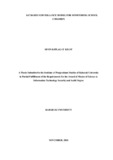IoT BASED SURVEILLANCE MODEL FOR MONITORING SCHOOL CHILDREN
Abstract
Children are naturally prone to accidents, exploitation, and various forms of abuse due to their inherent vulnerability, reliance on caregivers, and limited understanding of potential hazards and self-defense. Recent media coverage has highlighted an alarming rise in crimes targeting children, including abductions and murders, intensifying concerns about child safety. As children spend most of their time in school, ensuring their continuous monitoring and care becomes a shared responsibility of both the school and parents. The current method of accounting for children in Kenyan schools, involving physical head counts and class list checks, is long, tiresome, and inefficient, making it difficult to track learners' whereabouts throughout the day. To address these challenges, this research aims to develop an IoT-based surveillance system to monitor school children, leveraging technologies like Global Positioning System (GPS), Radio-Frequency Identification (RFID), Ultra-Wide Band (UWB), Bluetooth Low Energy (BLE), Infrared, Wi-Fi, and Zigbee. Collectively known as the Internet of Things (IoT), these technologies offer opportunities to enhance learner safety by enabling real-time monitoring of student movements on school premises. The study focuses on designing, developing, and evaluating an IoT-based surveillance model tailored to the needs of Kenyan schools. The model includes key components such as student registration, device registration, real-time tracking, and alert notifications. The research findings demonstrate that the developed model reliably monitors student movements in real-time, significantly enhancing school safety and addressing parental concerns about their children's whereabouts. Despite its effectiveness, challenges related to network reliability and data privacy were identified. The study concludes that IoT technology, when implemented with robust security protocols, can substantially improve child monitoring in educational settings. The research contributes to the field by offering a practical and scalable solution for real-time surveillance, emphasizing the importance of privacy safeguards. Recommendations include schools adopting IoT surveillance models to enhance student safety and governments creating supportive policies to facilitate the integration of IoT technology in schools while prioritizing data security.

